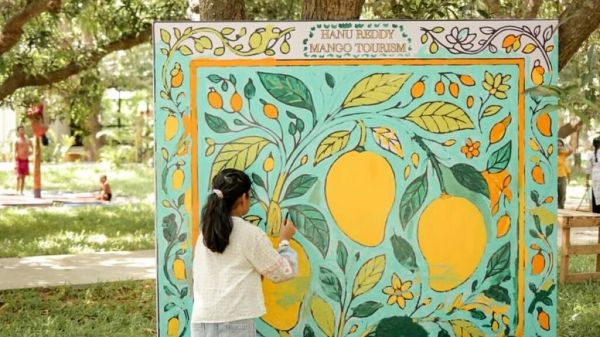
We started at thecrack of dawn, groggy-eyed and half-awake, but by 8 am, we found ourselves rolling into the sun-drenched expanse of Hanu Reddy Raghava Farms. Registration was swift, the energy already palpable, and soon we were following the trail of stalls and wagging tails that led us straight to where the action was.
A look at a mango festival at a Chennai farm
Despite just barely shaking off sleep, the vibe was infectious, people already buzzing, vendors setting up, dogs getting their daily dose of love pats, and music slipping through the trees. Somewhere between being dazed and intrigued, we stumbled upon Nirupa, who runs the operations at Hanu Reddy Farms and the Mango festival was her brainchild. Our curious minds were ready to interrogate her about the festival, but in true laid-back farm style, she grinned, “Go enjoy yourselves,” she said. “That’s the whole point.” And so, like obedient children at summer camp, we did.
We wandered, we gawked, and we sniffed out the smell of mangoes like bloodhounds. Soon, we found ourselves at a lavish mango spread that was no less than divine intervention for our tired souls. AAM RASmango salsamango jalebimango everything. Piling our plates like it was the Last Supper, we headed to a seat at the world’s longest table, 175 feet of pure togetherness. Imagine an English countryside long-table breakfast, but with Indian spice, mango dripping from fingers, and unfiltered joy in the air.
The table was made using wood felled during Cyclone Vardah, casuarina and eucalyptus trees repurposed as a symbol of resilience.
Next to us, a grandpa recounted stories of the good old days. Nearby, a wall invited people to scribble their favourite mango memories. The whole thing was like nostalgia had been served up with a side of pickled sunshine.
Armed with overconfidence and a catapult, we marched to the traditional sports section. Let’s just say our aim was so off, we’d probably endanger our own side in a war. But even one almost-hit had us cheering like we’d won Olympic gold. Next, we tried pottery. Instagram reels lied, it was not easy. But we tried. We failed with grace. We moved on.
These activities were part of the larger mission behind the festival: reviving lost arts and rural games through immersive, playful experiences. Kreeda Games had set up stations for bambaram, pallankuzhi, snakes and ladders, and kattam vilaiyaattu, turning the mango orchard into a living museum of Indian childhoods.
Somehow, amidst a field of children, we found our groove blowing giant bubbles and actually won that round. Don’t ask us how, but that victory was necessary.
With energy dipping, we took it slow, window-shopped at the earthy, eclectic stalls. This is where Hanu Reddy’s vision came alive: creating a bridge between local farmers and city folk. From organic produce to resin earrings and custom tees, every stall told a story. The goal wasn’t just mangoes, it was livelihoods. Many of the products were created by rural artisans and self-help groups, providing them direct access to a discerning urban audience.
Then came the giant snakes and ladders. Yes, like, floor-size. Yes, we played. Yes, we won again (we’re on a streak now). Victory deserved celebration, so we hung out with two adorable Indian country dogs and probably made some lifelong friends. Honestly, no therapy needed after this.Then it got real. We crushed grains the old-school way. We husked rice by hand. We even flung cow dung at a wall to make reserve (dung cakes used as fuel). We walked away with a deeper understanding of what it took in the “olden days” to cook even the simplest of meals. Dosa for breakfast suddenly felt like a luxury.
Just when we thought we’d seen it all, we came across a messy, kid-coloured paint station, cups knocked over, colours mixed, chaos at its finest. A mural on a wall begged us to join in. Brushes in hand, we added our strokes alongside mothers and their little artists. If there’s one thing this festival taught us, it’s that beauty lies in shared messes.
As we meandered again, we caught sight of a family bathing under a pump set. The laughter, the water splashing, the carefree squeals, it hit hard. Childhood nostalgia swept over us like a warm breeze.
We then found a ticket counter with mango-printed stubs. A narrow path led us to a bullock cart. What we thought would be a 10-minute jaunt turned into an over 25-minute retreat through the serene side of the farm. Along the way, we saw someone teaching farming basics, spotted a few peacocks, and soaked in the earthy calm before looping back into the main event.
The bullock cart rides and walking tours are part of the festival’s effort to promote agri-tourism, introducing city dwellers to rural rhythms, local biodiversity, and the slower pace of farm life.
The final pit stop? A mango-eating competition in full swing. Faces smeared, cheers ringing out, it was glorious. The winner walked away with 5 kilograms of mangoes and eternal bragging rights and we walked away with happy hearts.
-
Popular Pakistani actress found dead in her flat

-
Alia Bhatt’s former secretary arrested for cheating actress of Rs 77 lakh

-
MLC 2025: Team Qualifies For MLC Final Without Taking The Field

-
Public Sector Banks Fuel Government Coffers With Rs 5,304 Crore Dividend Boost

-
IndiGo Flight To Delhi Makes Emergency Landing In Patna After Bird Strike
